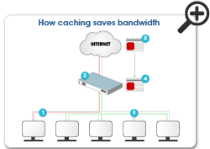 By serving web pages to your users from a local web cache, you need to fetch less data from the internet, saving you bandwidth and money.
By serving web pages to your users from a local web cache, you need to fetch less data from the internet, saving you bandwidth and money.
With intelligent caches like CACHEBOX, this also applies to the video and interactive learning content that your teachers want to use more of in the classroom. It further applies to the software updates, which can drain your bandwidth when all the devices in your computer lab are being updated.
Schools have very high levels of duplicate requests for identical online content, making caching extremely powerful. A school can easily achieve 50% savings and our top performing education deployments see over 75%.
Bandwidth savings translate into money in different ways in different organisations:
- No need to upgrade to a higher bandwidth connection
- Network equipment licence costs can be controlled and cloud egress fees reduced
- Direct cost savings on metered connections: less data traffic = lower bills
- Ability to support more users (perhaps for a 1:1 scheme) without increasing capacity
Teachers want to direct students to online educational content at the start of a lesson, but often abandon their lesson plans when students try to simultaneously access content and the network grinds to a halt.
Upgrading to higher bandwidth capacity may help. But most schools find that demand quickly grows to fill the new capacity as teachers who previously avoided using online resources in the classroom find them usable once more. Soon your new capacity is routinely congested again.
‘Peak’ demand at a school can easily be 4 times the average – leading to short (but frustrating) spells of congestion. Buying enough bandwidth to cater for these traffic spikes is not sensible or cost-effective.
Getting more out of your existing bandwidth – and the money saved as a result – is the #1 driver for using a cache in many cases. Often a simple Return on Investment calculation demonstrates a payback in months and makes it a “no-brainer”.
